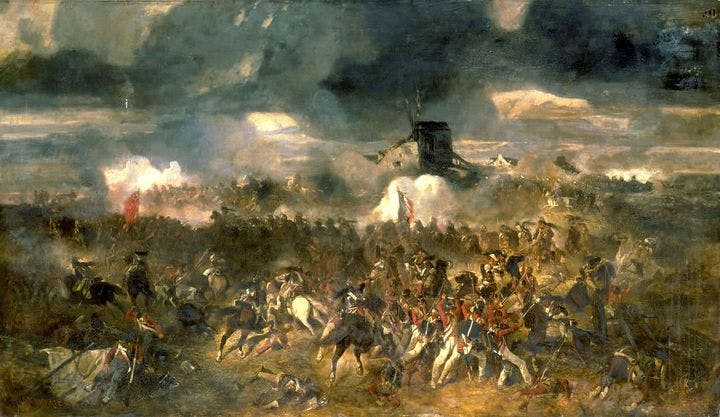Spring 2010
The Seeds of Defeat
– William Anthony Hay
The Battle of Waterloo was much more than an example of total defeat; It marked a pivotal event that made almost a century of peace possible in Europe.
The Duke of Wellington’s victory over Napoleon at the Battle of Waterloo, fought in Belgium in June 1815, has become synonymous with utter defeat. But Wellington himself noted the difficulty of explaining this historic encounter: “Some individuals may recollect all the little events of which the great result is the battle won or lost,” he later remarked, but none can recall their exact order or timing, “which makes all the difference as to their value or importance.”
British military historian Jeremy Black has solved the conundrum by synthesizing competing accounts into a sharp narrative that locates the battle within the wider context of warfare during the long 18th century. Into this discussion he weaves an account of the clash between Wellington, a soldier steeped in ancien régime war methods, and Napoleon, the revolutionary who had upended Europe. Their personalities shaped the battle and its outcome, and are one reason why Waterloo remains a subject of enduring fascination. But Black draws on his considerable erudition and archival experience (he is a former editor of the journal Archives) to show that the Battle of Waterloo—which destroyed Napoleon’s army and inflicted severe casualties on Wellington’s multinational force (British, Dutch, Belgian, and German)—was more than a clash of personalities. It marked a pivotal event that made possible almost a century of peace in Europe.
The prolonged warfare sparked by the French Revolution, Black points out, had driven tactical innovation, but many of the events at Waterloo were determined by methods of warfare that had remained largely unchanged in the nearly 20 years of constant conflict since Napoleon’s invasion of Egypt in 1798. Both sides relied on close-quarters fighting, which resulted in heavy casualties. Drill and discipline thus prepared units to remain intact and under their commander’s control in the face of death and injuries. Deploying soldiers in close formations maximized the effect of smooth-bore muskets with limited accuracy, and also served to counter the confusion and low visibility caused by the smoke that clouded the battlefield after the first volley.
Yet 18th-century warfare had a more dynamic character than these precise deployments and strict training suggest. In the American War of Independence, both France (which intervened in 1778 on the American side) and Britain were required to project power overseas and operate in environments that demanded flexibility. From 1789 onward, the French Revolution cleared the way for military innovations—including conscription and the use of divisions, units of combined arms that could operate independently or together—that Napoleon developed and systematized. Massed infantry columns, which overwhelmed his enemies’ defensive lines, as well as improved forms of technology such as more mobile artillery, were key to Napoleon’s military victories. Black compares Napoleon to Britain’s naval hero, Horatio Nelson, in his determination to engage the enemy and win.
The careers of Napoleon and Wellington traced intersecting trajectories during the decade before their encounter at Waterloo. Napoleon dominated Europe by defeating the armies of his rivals, but overreached by invading Russia in 1812. Wellington gained his first experience during failed expeditions in the Netherlands during the 1790s, then won renown in India in campaigns that consolidated British power in the subcontinent. He expressed confidence in his ability to take on the French, mainly because he regarded their innovative system as weak against troops with enough discipline to hold their position.
Waterloo came about as a result of Napoleon’s bid to regain the French throne after his exile to Elba the previous year. The allied powers, busy negotiating a European settlement at the Congress of Vienna, scurried to respond. Napoleon first met a Prussian army whose defeat alerted Wellington to the location of the French army and deprived Napoleon of the element of surprise. At Quatre Bras and then two days later near the village of Waterloo, British infantry staved off French attacks. Wellington chose his ground well, encamping on a ridge that afforded him access to Prussian support. In the battle that followed, Napoleon’s blunt attacks, using heavy cavalry and infantry in columns, met their match in Wellington’s defensive formations of lines and hollow squares that enabled British infantry to withstand the shock of cavalry charges. It was the army that embodied change that was routed, and Napoleon’s overthrow in France followed days later.
Waterloo was a crucial victory in what Black calls “the struggle against the unreason of tyranny” to bring Europe a century of peace and liberal capitalism. But the battle’s toll on both sides prompted Wellington’s reflection that nothing except a battle lost can be half so melancholy as a battle won.
* * *
William Anthony Hay is an associate professor of history at Mississippi State University and a fellow of Britain's Royal Historical Society. He is the author of The Whig Revival, 1808-1830 (2005).
Reviewed: "The Battle of Waterloo" by Jeremy Black, Random House, 2010.
Image courtesy of Wikimedia Commons
